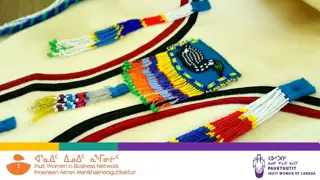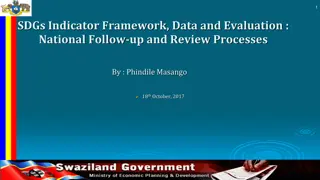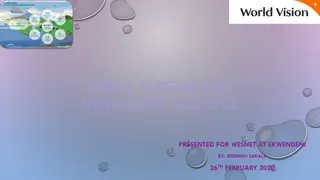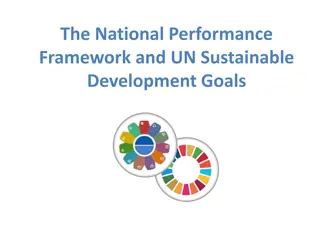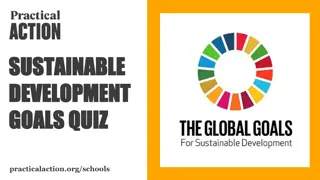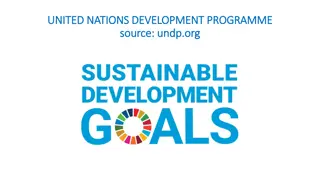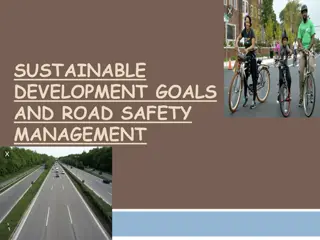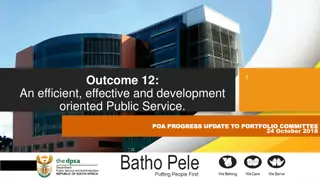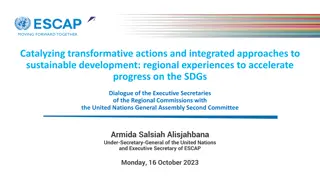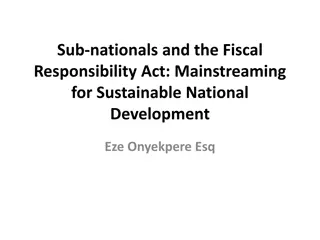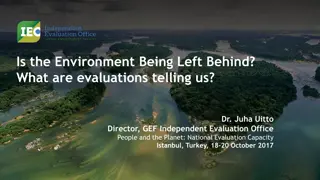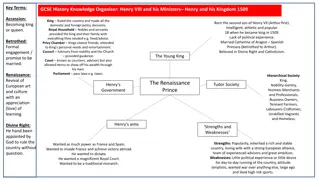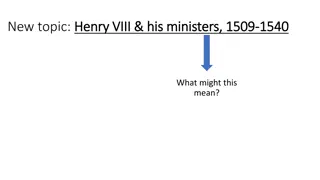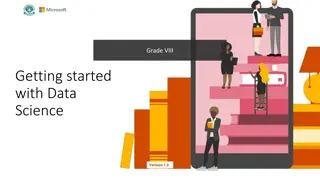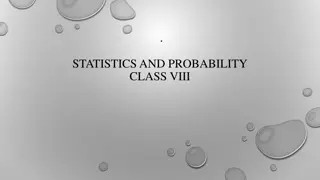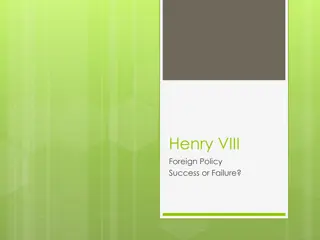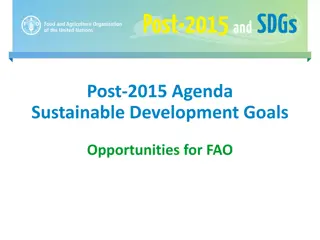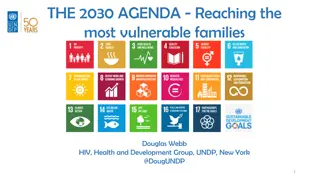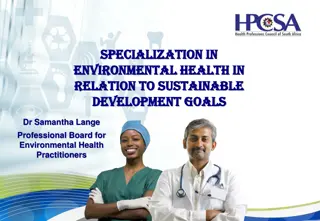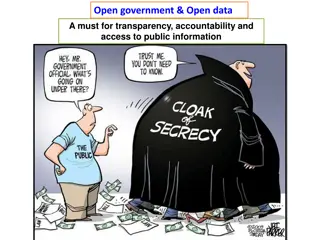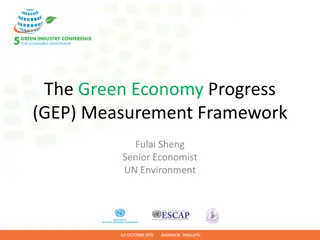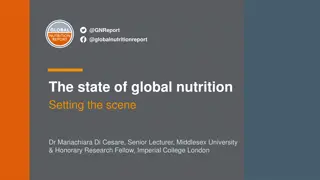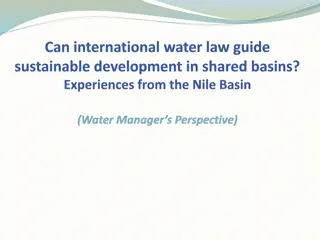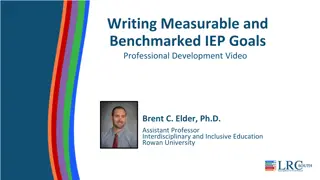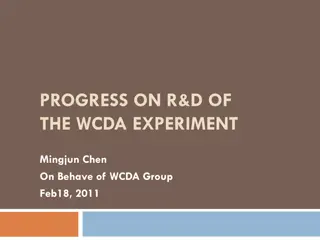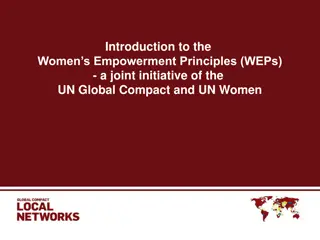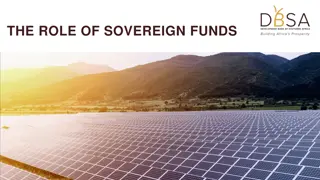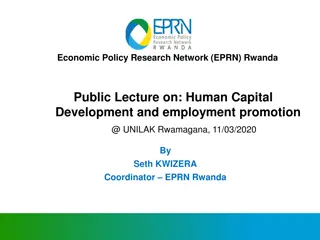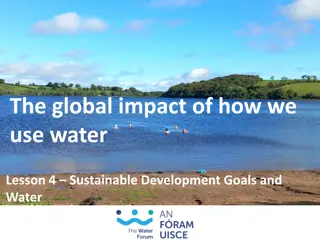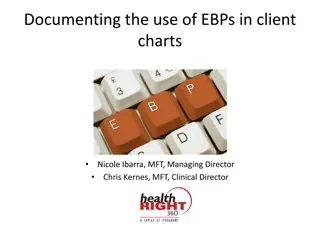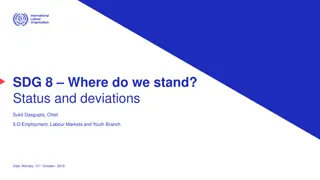Sustainable Development Goals Group VIII Progress Report
Highlights achievements and challenges in meeting climate action goals in Assam, focusing on collaboration, policy improvement, funding, and capacity building. Emphasizes integrating climate change measures into national policies and building resilience in the face of natural disasters.
Download Presentation

Please find below an Image/Link to download the presentation.
The content on the website is provided AS IS for your information and personal use only. It may not be sold, licensed, or shared on other websites without obtaining consent from the author. Download presentation by click this link. If you encounter any issues during the download, it is possible that the publisher has removed the file from their server.
E N D
Presentation Transcript
Group VIII Goal-13 Climate Action Goal-14 Life Below Water Goal-15 Life On Land SDG Group-VIII 1
Departments/ Agencies Involved Forest (including Wildlife) Assam State Biodiversity Board Fisheries Water Resources Soil Conservation Assam State Disaster Management Authority SDG Group-VIII 2
Highlights Group met on more than 2 occasions e-mail group interactions Each one shared the work-plan Learning on climate change related issues SDG Group-VIII 3
Observation Many inter-related issues: Need for Collaboration (with other groups as well) Overarching monitoring Mechanism Policy issue need a common platform for Improving synergy Avoiding cross-purpose activities Significant targets need commensurate fund Common platform for seeking externally aided funds SDG Group-VIII 4
Climate Action FOREST DEPARTMENT SDG Group-VIII 5
Goal 13: Climate Change Targets Targets- Global Target-Assam Indicator Time frame Strengthen resilience and adaptive capacity to climate-related hazards and natural disasters in all countries Assam SAPCC prepared in tune with the NAPCC SAPCC approved by the GoI 2016 Integrate climate change measures into national policies, strategies and planning All Sectoral polices are in conformity with SAPCC Assam Climate Change Management Society in place ACCMS meets regularly to launch policy initiatives monitor implementation 2016 2016 onwards Improve education, awareness-raising and human and institutional capacity on climate change mitigation, adaptation, impact reduction and early warning Sensitizing vulnerable sections of society and concerned departments Awareness workshops State level, District level and village level 2016 on wards 2017 Capacity building of stakeholders 2020 Early warning systems in place SDG Group-VIII 6
Implement the commitment undertaken by developed- country parties to the United Nations Framework Convention on Climate Change to a goal of mobilizing jointly $100 billion annually by 2020 from all sources to address the needs of developing countries in the context` of meaningful mitigation actions and transparency on implementation and fully operationalize the Green Climate Fund through its capitalization as soon as possible Project formulation for priority sectors National and International funding accessed for Pilot Projects 2017 At least 5 Projects Submitted/launched with support from 5 major Donors 2017 SDG Group-VIII 7
Promote mechanisms for raising capacity for effective climate change- related planning and management in least developed countries and small island developing States, including focusing on women, youth and local and marginalized communities Strengthen resilience and adaptive capacity to climate-related hazards and natural disasters in all countries Pilot Projects prepared 2017 Launched 2018 target groups showed measurable adaptive capacities 2020 SDG Group-VIII 8
Goal 14: Life Below Water By 2025, prevent and significantly reduce marine pollution of all kinds, in particular from land-based activities, including marine debris and nutrient pollution Project on Wetland Inventory / Status Study / Interventions A coordinated Project in place 2017 By 2020, sustainably manage and protect marine and coastal ecosystems to avoid significant adverse impacts, including by strengthening their resilience, and take action for their restoration in order to achieve healthy and productive oceans Minimize and address the impacts of ocean acidification, including through enhanced scientific cooperation at all levels SDG Group-VIII 9
Goal 15: Sustainably manage forests, combat desertification, halt and reverse land degradation, halt biodiversity loss Targets- Global Target-Assam Indicator Time frame By 2020, promote the implementation sustainable management of all types of forests, halt deforestation, degraded forests substantially afforestation reforestation globally 1. Sustainable forest management through Working Plans 1. Revise 32 Working Plans 1. All PWPR by 2017; WP by 2020 of 2. Obtained approval on these WP 2. 2020 restore and increase 3. Implement prescriptions of approved WP 3. 2020 onwards and 1. Secure vulnerable forests 4000 ha RF are By 2020 @ 1000 ha per year 1. Afforest degraded forests 20000 ha @ 2000 ha. every year SDG Group-VIII 10
By 2030, ensure the conservation of mountain ecosystems, including their biodiversity, in order to enhance their capacity to provide benefits that are essential for sustainable development Hill area of state are secured and protected against encroachment, tree felling, soil cutting and mining 1.Strong legislation in place 1. by 2017 2.Offenders prosecuted 2. 2017 onwards 3.Hill area regenerate/ man- animal conflicts reduced 3. 2018 onwards Take urgent and significant action to reduce the degradation of natural habitats, halt the loss of biodiversity and, by 2020, protect and prevent the extinction of threatened species 1. Critical habitat identified 2. Biodiversity inventoried 3. Threatened species focused conservation launched 1. Landscape mapping completed 1. by 2017 2.Biodiversity Registers in place 2. by 2017 3. State Biodiversity Strategy and Action Plan ready 3. By 2017 SDG Group-VIII 11
Promote fair and equitable sharing of the benefits arising from the utilization of genetic resources and promote appropriate access to such resources, as internationally agreed State Access-and- Benefit-Sharing (ABS) mechanism finalized At least 10 ABS put in place between people and commercial users of bio-resources 2 ABS by 2017 2-3 ABS Every year Take urgent action to end poaching and trafficking of protected species of flora and fauna and address both demand and supply of illegal wildlife products Poaching of Rhino and other scheduled animals controlled 1. Poaching incidents drastically reduced / poachers arrested and prosecuted 2.population of Rhino steadily grows Poaching control data every year is better than the previous year Census of wildlife shows healthy trends By 2020, introduce measures to prevent the introduction and significantly reduce the impact of invasive alien species on land and water ecosystems and control or eradicate the priority species Area under Invasive species of both land and water is drastically reduced Control of Lantana, Parthenium, on land, 1000 ha. Control of Eichhornia, in wetlands 5 major wetlands and 20 other wetlands By 2016 onwards @ 100 ha every year By 2016 onwards @ 2-3 Wetlnds every year SDG Group-VIII 12
By 2020, integrate ecosystem and biodiversity values into national and local planning, development processes, poverty reduction strategies and accounts Assessment Ecosystem values of Biosphere reserves and Protected Areas Ecosystem value Assessed 2 Biosphere Reserves, 5 National Parks 20 WL Sanctuaries By 2018 By 2020 By 2025 Ecosystem Values integrated with revenue earned in State Planning 2020 Mobilize and significantly increase financial resources from all sources to conserve and sustainably use biodiversity and ecosystems Externally Aided Projects / Green Climate Fund / Climate Adaptation Fund At least one project for CC actions for each funding agency Submitted Launched in Assam 206-17 2018 onwards Mobilize significant resources from all sources and at all levels to finance sustainable forest management and provide adequate incentives to developing countries to advance such management, including for conservation and reforestation Externally Aided Projects / Green Climate Fund / Climate Adaptation Fund One mega project in Forest & Biodiversity conservation sector 2018 SDG Group-VIII 13
DRAFT ACTION PLAN FISHERIES SECTOR SDG Group-VIII 14
GOAL 14. LIFE BELOW WATER 14.4 By 2020, effectively regulate harvesting and end overfishing, illegal, unreported and unregulated fishing and destructive fishing practices; implement science-based management plans, in order to restore fish stocks in the shortest time feasible, atleast to levels that can produce maximum sustainable yield as determined by their biological characteristics ACTION Awareness for all stakeholders INDICATOR Atleast 1 awareness programme in each development blocks TIME BY 2018 Penalization of defaulters Defaulters reduced to nil with 20% reduction every year 2020 Information on existing legal provisions to all the stakeholders Formal communication 2016 SDG Group-VIII 15
GOAL 14. LIFE BELOW WATER 14.4 contd . ACTION Complete ban on culture/ marketing of prohibited exotic fishes Workshop for need based amendment of the legal provisions INDICATOR Zero in the market or catch composition TIME BY 2020 2 state level workshop conducted 2017 Hiring legal consultants to formulate necessary amendments Study Commissioned Final draft 2016 2018 Amendments of the legal provisions Acts and Rules in place 2019 Better management to prevent fish disease 50% Reduction in mortality due to disease or pollution 2020 SDG Group-VIII 16
GOAL 14. LIFE BELOW WATER 14.6 By 2020, prohibit certain forms of fisheries subsidies which contribute to over capacity and overfishing, eliminate subsidies that contribute to illegal, unreported and unregulated fishing and refrain from introducing new such subsidies, recognizing that appropriate and effective special and differential treatment for developing and least developed countries should be an integral part of the World Trade Organization fisheries subsidies negotiation REMARKS Presently Fisheries Department, Govt of Assam is implementing no subsidy oriented schemes which contribute to over capacity and overfishing in the natural waters. However, effective leasing policies to prevent over-exploitation of the beel and river fisheries would be addressed through the actions mentioned in 14.5 SDG Group-VIII 17
GOAL 14. LIFE BELOW WATER 14.7 By 2030, increase the economic benefits to Small Island Developing states and least developed countries from sustainable use of marine resources, including through sustainable management of fisheries, aquaculture and tourism ACTION Organic fish farming INDICATOR State specific Guideline- Draft ready TIME BY 2017 Identification and selection of suitable area/villages 2018 Experimental Organic fish farming in atleast 5 villages/clusters 2020 Coverage of additional 20 villages/clusters 2028 SDG Group-VIII 18
GOAL 14. LIFE BELOW WATER 14.7 contd ACTION INDICATOR TIME BY Culture based fisheries in selected beels 100 beels or 3000 ha/ year Development of 30000 ha 2016 onwards 2030 Semi- intensive aquaculture in ponds At least 1 such pond in each village (@ 200 villages / year ) 2016 onwards 2030 Total of - 50000 ha 500 ha per year Development of 5000 ha Intensive aquaculture in ponds of progressive fish farmers 2016 onwards 2025 Fish stock enhancement in swamp and derelict bodies 20 such bodies / year Covering 20,000 ha 2016 onwards 2025 Integrated fish farming in existing ponds 5% of ponds / year 2016 onwards SDG Group-VIII 19 At least 50% potential ponds 2022
GOAL 14. LIFE BELOW WATER 14.7 contd ACTION INDICATOR TIME BY Management interventions like conservation and ranching in large riverine and reservoirs resources Increase production from capture fisheries by atleast 10% 2020 Holistic development of beel fisheries for production enhancement 3 Model Beels in each district 2020 Capacity building on ornamental fish breeding and marketing etc. 50 unemployed youth per district 2018 Entrepreneurship development on ornamental fishes Establishment/upgradation of 10 backyard hatcheries and aquarium fabrication units in each district SDG Group-VIII 2020 20
GOAL 14. LIFE BELOW WATER 14.a -Increase scientific knowledge, develop research capacity and transfer marine technology, intergovernmental, oceanographic commission criteria and Guidelines on the Transfer of Marine Technology, in order to improve ocean health and to enhance the contribution of marine biodiversity to the development of developing countries, in particular small island developing states and least developed countries taking into account the ACTION Capacity building for increasing income through scientific and sustainable management Capacity building of the departmental extension functionaries INDICATOR Cover at least 25% of the fish farmers of the state To cover all the technical officers and staff Preparation and approval of final draft SDG Group-VIII TIME BY 2020 2020 Policy formulation for engagement of para-extension workers 2018 21
GOAL 14. LIFE BELOW WATER 14.a contd ACTION Engagement and training of para- extension workers INDICATOR 1 para-extension worker in place for each village TIME BY 2023 Feed-back to research institute on the technological needs Continuous process Cataloguing of indigenous fish species Publication of inventories of indigenous fish species 2019 Standardization of breeding and propagation protocol of popular but endangered fish species Protocol standardization for atleast 10 species on priority basis 2020 SDG Group-VIII 22
GOAL 14. LIFE BELOW WATER 14.b - Provide access for small scale artisanal fishers to marine resources and markets ACTION INDICATOR TIME BY Assess the status of participation of riparian fishers Conduct and complete a survey 2018 Policy formulation for inclusive participation of riparian Relevant provisions in place followed by approval 2020 Implementation of the relevant provisions Access of 80% of the riparian fishers to natural aquatic resources and 50% of them to the market 2027 Participation of women riparian fishers in productive and income generating fisheries activities Commissioning of atleast 500 small scale units 2023 SDG Group-VIII 23
GOAL 14. LIFE BELOW WATER 14.c -Enhance the conservation and sustainable use of oceans and their resources by implementing international laws as reflected in UNCLOS, which provides the legal framework for conservation and sustainable use of oceans and their resources, as recalled in paragraph 158 of The Future We Want ACTION INDICATOR TIME BY Declaring parts of wetland and rivers as protected areas To cover 1% area of each beel and 5% stretches of each river fisheries 2020 REMARKS Enhancement, conservation and sustainable use of freshwater resources would be addressed through the actions mentioned in other relevant paras SDG Group-VIII 24
GOAL 15. LIFE ON LAND 15.1 - By 2020, ensure the conservation, restoration and sustainable use of terrestrial and inland freshwater ecosystem and their services, in particular forests, wetlands, mountains, and dry lands, in line with obligations under international agreements ACTION GIS based survey, listing and categorization of all the natural inland wetlands INDICATOR Collection of existing data from other department and institute TIME BY 2018 Creation of a complete database 2020 State preparedness for Wise use of the wetlands in the state (in the line with international conventions Sorting out relevant provisions where India is a signatory 2017 Identifying the stakeholders and making them aware 2019 To encompass all the natural inland wetlands SDG Group-VIII 2027 25
GOAL 15. LIFE ON LAND 15.1 contd ACTION INDICATOR TIME BY Conservation of the selected wetlands/ water bodies reserved under forest jurisdiction as live gene bank for the indigenous fish species Consultation with Forest Dept. Wetlands identified Works initiated 2016 2017 2017 Draft policy formulation 2018 Management of live gene bank 2020 onwards SDG Group-VIII 26
WATER RESOURCES DEPARTMENT SDG Group-VIII 27
Working Group-VIII: Climate Change, Life below water & life above Land (Para 15.3 Life on Land) ACTIONS INDICATOR TIME FRAME Digitization of existing data system Upgrading manual data collection system to real time data acquisition system (RTDAS) Upgradation of existing River Research Station to Assam water Research and Management Institute (AWRMI) Digitizing and archiving data 2020 Effective early forecasting leading to timely evacuation Mitigation Reduced loss of life and livestock SDG Group-VIII Development of advanced flood forecasting system 2025 28
TIME FRAME ACTIONS INDICATOR Flood Risk mapping and flood zoning Risk zone atlas prepared Long term erosion risk mapping. Use of modeling technologies to improve decision making. 2022 Zone specific information for improved decision making Preservation of water-bodies Growth of aquatic flora & fauna 2020 Channelization of Brahmaputra river to reduce loss of land mass by adopting About 300Km upper reach from Dibrugarh to Tezpur by 2024 Channelization works. About 130Km middle reach from Nagaon to Guwahati by 2027 Corrective dredging of river bed for maintaining stable river regime. Bank protection migration of river bank. River training works. 2025 works to check About 210Km lower reach from Guwahati to Dhubri by 2030 SDG Group-VIII 29
TIME FRAME ACTIONS INDICATOR Practice of using eco-friendly construction material as geo-bags for erosion protection, geo- tube dykes for embankment construction. Reduction in damage for forest resources 2016 onwards. Development of drainage network system as well as proper maintenance in major towns like Dibrugarh, Jorhat, Silchar and capital city of Guwahati. Reduction in the incidents of flash flood in the cities. 1 major city every year Promotion management through possible techniques such as check dams, contour preservation of forests, increasing the forest cover, etc. to increase time of run-off and retain top soil cover. of Sustainable Watershed Reduction in intensity of flood and silt load in rivers. trenches etc., 2022 SDG Group-VIII 30
Working Group-II: Healthy well being and sanitation to all (Para 6.5 Clean water and sanitation) TIME FRAME ACTIONS INDICATOR Common watershed platform for all the NE states and its neighbouring countries viz. Bhutan, Bangladesh and China to achieve sustainable and all round development of Assam in particular including North Eastern region and this part of South East Asia as a whole. Creation of the Common platform 2018 This platform will enable the stakeholders ease of data sharing for better formulation of integrated water resources management programmes. Framing basin wise comprehensive proposals 202 W R Deptt., Assam have been framing comprehensive and integrated water resources management proposals considering vulnerable reaches river basin-wise. implementation of schemes 2022 SDG Group-VIII 31
Working Group-I: Poverty alleviation, education to all, etc. (Para 2.4 Zero Hunger) TIME FRAME ACTIONS INDICATOR Strengthening the dyke system in phase manner. About 328.93Km upper reach from Dibrugarh to Tezpur by 2024 About 210.96Km middle reach from Nagaon to Guwahati Fortification of Brahmaputra dyke system. In this project about 736.00 Km length (Both Banks) of embankment Brahmaputra will be raised and strengthened including extension of embankments at some reaches. 2024 along river 2027 About 196.00Km lower reach from Guwahati to Dhubri 2030 Fortification of dyke system of independent rivers like Borak including tributary rivers of Brahmaputra & Borak river of about 2788.31 Km of vulnerable dykes of tributary rivers of the state to reduce the flood hazard will be taken up for implementation. Strengthening the dyke system in phase manner. 2024 About 1000 Km. 2027 Another 1000Km. 2030 Remaining 788.31 Km. SDG Group-VIII 32
SOIL CONSERVATION DEPARTMENT GOVT. OF ASSAM
TARGETS Para Para 15 15. .3 3. . By 2030, combat desertification, restore degraded land and soil, including land affected by desertification, draught and floods, and strive to achieve a land degradation neutral world. Para Para 15 15. .4 4. . By 2030 ensure the conservation of mountain Ecosystem, including their biodiversity, in order to enhance their capacity to provide benefits that are essential for sustainable development.
ACTIONS (Para15.3 ) 1. State soil atlas with the perspectives of developing intervention plan for Soil treatment, erosion control and slope stabilization: Print ready atlas available in digital form using GIS platform for all purpose of soil conservation and protection planning; ready by 2022. 2. State agro-climatic zone wise States species inventory development for plantation and vegetative treatment: List of inventory of the species for plantation will be available to concern agencies and different division of the department against each of the agro-climatic zones of the state; ready by 2022. 3. Policy on: Draft policy make available to the public for opinion and suggestion ; ready by 2022. a) Land use and land use regulation act . b) Soil and water conservation policy and act.
ACTIONS (Para15.3 ) 4. Intervention for Soil Treatment a) Slope stabilization and restoration by vegetative and structural approach and in combination: 30% slope destabilized will be covered- by 2023. b) Soil organic matter restoration and nourishment:35% of the dry farmland will be covered - by 2023. c) Bio-sore application and terapetra treatment: 20% of the dry farm land will be covered by 2023 . 5. Intervention for Water Harvesting a) Water harvesting through farm pond: 35 % of the draught prone area will covered- by 2024. b) Water harvesting through improvisation of traditional water harvesting method like Dong, Longsor :30 % of the draught prone area will covered- by 2024. c) Farmland neighbourhood water body conservation and field canal connection along with field bund:35 % of the draught prone area will covered-by 2024.
ACTIONS (Para15.3 ) 6. Development state wasteland data base and State guideline on Wasteland development: Guidelines - by 2024. 7. Interventions for Wasteland Treatment a) Plantation: 10% waste land area of the state - by 2025. b) Wild fruits, herbs orchard development: 10% waste land of the state- by 2025. c) Plantation of suitable species on sand casting areas : 15% sand casting area- by 2025. d) Plantation of NTFP/MFS species, like broom grass, castor plant etc: 5% asteland area palnted - by 2025 .
ACTIONS (Para15.3 ) 8. Community based wetland management model development: Demonstration model of Community based wetland management against each agro-climatic zone: least one model site for each agro-climatic zones - by 2025. 8. State wetland development and restoration Policy: Draft policy made available to the public for opinion and suggestion- by 2018. 8. State agro-forestry policy: Draft policy developed in tune with national policy Public consultations Finalization by 2018 8. Agro-climatic zone wise agro-forestry model: Demonstration of Community base Agro-forestry model against each agro-climatic zone- by 2020 . 8. Soil health card for farmers: Farmers posses soil health card in all the districts -by 2025.
ACTIONS (Para15.4 ) 1. Awareness on soil resource management, protection and conservation: Awareness Program / Module Developed by 2017 Programmes held in each Village Panchayats @ 200 /year 2. Alternative approach to control Jhum in Hill districts: Study commissioned 2017 Agro-forestry model development 2020 Pilot Program launched 2021 3. Protection & development of Sacred Forest, Village / Community Forest & Council Forest: Study commissioned on inventory & drafting management Plans 2017 Management Plans ready 2020 At least 10 Management Plans supported 2021.
4. Hill district wise guideline development on watershed basis with due consultation Autonomous District of Hill area Study commissioned for development of Guideline by 2017 Draft Guidelines by 2020 1. Awareness on soil and water conservation: Awareness Module developed - 2017 Awareness Programmess in each District / Block / Villages 2025. ( clubbed with soil management program) SDG Group-VIII 40
Draft Action Plan for Assam State Disaster Management Authority SDG Group-VIII 41
Goal Action Indicator Time by Strengthen resilience and adaptive capacity to climate-related hazards, natural disasters in all countries 1. Develop an Integrated Action Plan for all Hydromat Disasters with particular reference to climate change (Agriculture, Education, Environment and Forest, Health & FW, Soil Conservation, PWD, Social Welfare, Power, P & RD Departments) - Prepared Community based Adaptation and Mitigation Guidelines -2017 - Prepared Integrated Action Plan for Implementation -2018 -Community based Adaptation and Mitigation Plan -2020 2. Infrastructure strengthening of Community based flood early warning system - Flood Early Warning dissemination upto village level across the State -2020 SDG Group-VIII 42
Goal Action Indicator Time by Strengthen resilience and adaptive capacity to climate-related hazards, natural disasters in all countries 3. Integration of Climate Change and Disaster Risk Reduction concerns into flagship programmes - Identification of programmes/schemes - Selection of Pilot Programmes - Sensitization of officials - Implementation in pilot program - Preparation of Framework - Workshops - Demonstration of a Pilot Programme on Integration 2020 - Implementation of the entire pilot 2030 4. Construction of multipurpose flood shelter with 500 people/unit in Dhemaji, Lakhimpur, Barpeta, Morigaon and Majuli - Completion of 5 flood shelters at Dhemaji, Lakhimpur, Barpeta, Morigaon and Majuli 2025 SDG Group-VIII 43
Goal Action Indicator Time by 1. Build Aware Community on DRR and climate change adaptation Training and Capacity Building of Departmental functionaries of Agriculture, Environment and Forest, Health & FW, Soil Conservation, PWD, Social Welfare, Power, P & RD Departments Sensitize Departments changed role and functions due to the impact of Climate Change Improve education, awareness-raising Development of IEC material, information capsules, conversation modules etc. Minimum of 20 Workshops with Departments 2017 and human and Education, institutional capacity on climate change mitigation, on 2020 adaptation, impact done reduction and early warning SDG Group-VIII 44
Goal Action Indicator Time by Promotion of community based indigenous adaptation strategies for Hydromat Disasters Improve education, awareness-raising Completed Study Report 2018 and human and Study/Documentation of existing strategies/ coping mechanism and documentation of Best Practices Large scale sensitization and awareness generation regarding Best Practices institutional capacity on climate change -Sensitization completed at Block and PRI level in all 27 districts 2020 mitigation, adaptation, impact reduction and early warning SDG Group-VIII 45
Thank You SDG Group-VIII 46


